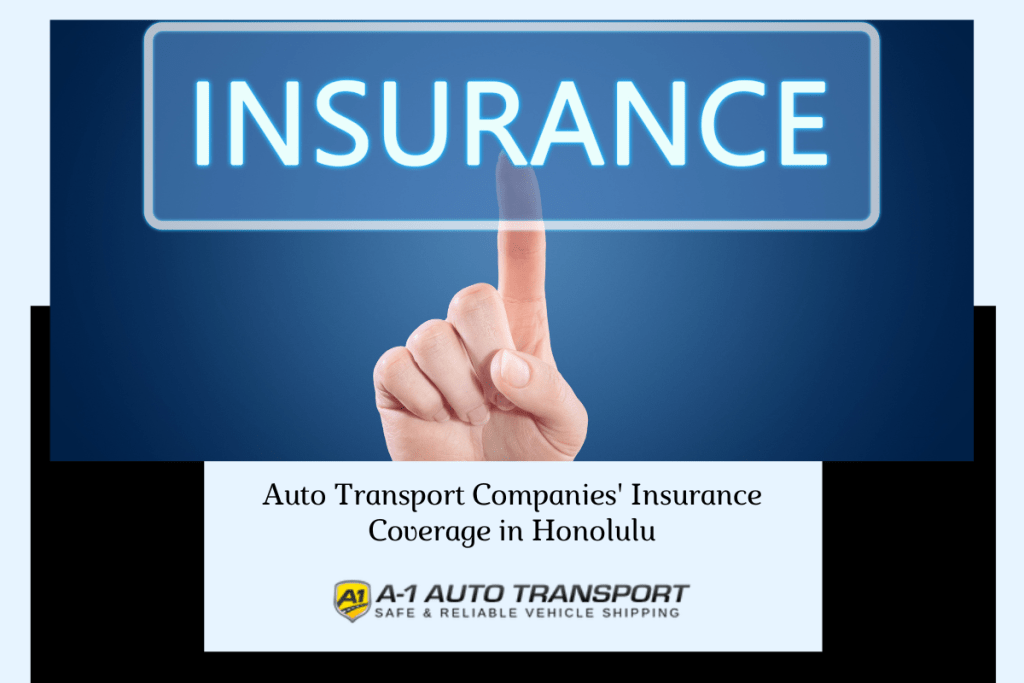
When shipping a car in Honolulu, it's essential to understand the insurance coverage provided by auto transport companies. These companies typically offer three types of insurance coverage: comprehensive coverage, liability coverage, and cargo insurance. Comprehensive coverage protects against theft, vandalism, and natural disasters. Liability coverage handles damages caused by the transport company during loading and transit. Cargo insurance specifically covers the vehicle itself during shipment. Verifying the specifics of each policy and ensuring adequate coverage can provide peace of mind that your vehicle will arrive safely and in the same condition as it was picked up.

Types of Insurance Coverage Offered by Auto Transport Companies
When you're considering shipping a car, understanding the types of insurance coverage offered by car shipping companies is essential for complete peace of mind. Auto transport companies typically provide three main types of insurance coverage: comprehensive coverage, liability coverage, and cargo insurance.
Comprehensive Coverage
Comprehensive coverage is a broad policy that protects your car against a variety of risks during transit. This type of insurance covers damages caused by theft, vandalism, natural disasters, and accidents. If your vehicle is being shipped to Hawaii, particularly to the Big Island, comprehensive coverage ensures that you’re protected from any unforeseen incidents. Additionally, comprehensive coverage often includes protection against issues like leaking fluids, which could damage other vehicles during the shipping process.
Liability Coverage
Liability coverage is a basic insurance policy that auto shipping companies must carry by law. This coverage protects against damages caused by the shipping company’s negligence. For example, if the carrier damages your car during loading or unloading, liability coverage will handle the repair costs. This type of insurance coverage is crucial when using an enclosed carrier, as it offers protection during the entire shipping process. However, it's important to verify the coverage limits to ensure they are adequate for your specific vehicle.
Cargo Insurance
Cargo insurance covers the car itself as part of the shipment. This insurance is particularly important when shipping high-value vehicles or classic cars. Cargo insurance ensures that if your car is damaged while in transit, the repair or replacement costs are covered. For instance, if you are shipping your car from San Diego to Honolulu, cargo insurance provides an extra layer of security against potential transit damages.
Choosing the right type of insurance coverage depends on several factors, including the value of your car, the specific route, and whether you're using enclosed or open transport. Always verify that the car shipping company is fully insured to avoid any surprises.

How to Verify the Insurance Coverage of Auto Transport Companies
Verifying the insurance coverage of car shipping companies is a crucial step to ensure your vehicle is protected during transit. Here are the steps to verify the insurance coverage, the necessary documents, and potential red flags to watch out for.
Steps to Verify
- Request Documentation: Start by requesting a copy of the insurance policy from the auto transport company. This document should outline the coverage details and limits.
- Check Validity: Verify the insurance policy's validity by contacting the insurance provider directly. Ensure the policy is active and covers the specific route your car will take, such as Hawaii shipping.
- Review Coverage Limits: Ensure the coverage limits are sufficient for your vehicle's value. For example, if you have a high-value car or are shipping vehicles to the Big Island, make sure the insurance covers potential replacement costs.
Documents Required
- Certificate of Insurance: This document proves the auto shipping company is insured. It should include details like the policy number and coverage limits.
- Bill of Lading: This is a critical document in the shipping process that outlines the condition of your vehicle at pick-up and delivery. Ensure the car’s condition, vehicle color, and any pre-existing damages are noted.
- Insurance Policy Document: This provides a comprehensive overview of the coverage, including any exclusions or conditions.
Red Flags
- Unwillingness to Provide Information: If the shipping company hesitates or refuses to provide insurance details, consider it a red flag.
- Insufficient Coverage: Make sure the coverage is not limited to minimal amounts that won't cover your vehicle's value. This is especially important for high-value shipments, such as using enclosed carriers.
- Lack of Transparency: Be wary of companies that are not transparent about their insurance policy or have vague terms.
By following these steps, you can ensure that your car is shipped safely and that you have complete peace of mind throughout the shipping process. Whether you're shipping a car to Hawaii or another location, verifying the insurance coverage will protect your investment from potential risks.
Common Exclusions in Auto Transport Insurance Policies
When shipping a car, understanding the common exclusions in auto transport insurance policies is crucial. Auto shipping companies provide insurance coverage, but there are specific items and conditions that typically aren't covered. Here's a detailed look at what you need to watch out for.
- Personal Belongings Most car shipping companies do not cover personal belongings left inside the vehicle. Items like floor mats, jumper cables, and spare tires are generally excluded from insurance coverage. It’s recommended to remove all personal items before shipping a car to ensure they aren’t damaged or stolen.
- Pre-existing Damage Insurance policies often exclude any pre-existing damage to the vehicle. Before shipping, conduct a thorough inspection and document the car’s condition, including the vehicle color and any existing scratches or dents. This documentation should be included in the bill of lading at pick-up and during the final inspection upon delivery.
- Leaking Fluids Damage caused by leaking fluids from other vehicles is usually not covered. Ensure your car is in good condition and check for any leaks before shipping. This helps avoid disputes over damage caused by other vehicles during transit.
- Size Restrictions and Modifications Vehicles with modifications or that exceed standard size restrictions may not be fully covered. For example, custom modifications or oversized tires might be excluded from the policy. It’s important to check with your auto shipping company to understand these limitations.
- Improperly Secured Vehicles If the vehicle isn’t properly secured or prepared for transport, insurance claims might be denied. This includes ensuring the car is empty of personal items, and that any items left are properly secured.
- Acts of Nature Natural disasters, such as hurricanes or floods, are typically excluded from auto transport insurance policies. Comprehensive insurance may cover these events, but it’s best to verify this with your provider.
- Unauthorized Routes Shipping a car on a route not specified in the contract can void the insurance coverage. Always confirm the specific route with the car shipping company to avoid any issues.
By understanding these common exclusions, you can take steps to ensure your vehicle is shipped safely and with complete peace of mind.

Steps to File an Insurance Claim with Auto Transport Companies
If your car is damaged during transport, knowing how to file an insurance claim with auto transport companies is essential. Here’s a step-by-step guide to ensure the process goes smoothly.
- Document the Damage : Upon delivery, inspect your car thoroughly. Note any new damage compared to the condition documented at pick-up. Take clear photos of the damage, focusing on specific areas like the vehicle color, dents, or scratches. This documentation is crucial for your claim.
- Notify the Transport Company : Inform the car shipping company about the damage immediately. Most companies require you to report the damage within a specific time frame, often within normal business hours of delivery. Ensure you do this promptly to avoid complications.
- Gather Required Documentation : Collect all necessary documents, including the bill of lading, photos taken during the final inspection, and any other relevant paperwork. You might also need to provide your license plate number and the original shipment contract.
- Submit the Claim : Fill out the insurance claim form provided by the auto shipping company. Include all required documentation and a detailed description of the damage. Submitting this electronically can speed up the process, as some companies allow for electronic transfer of documents.
- Follow Up : After submitting your claim, follow up with the car shipping company regularly. Keep records of all communications, including emails and phone calls. This helps ensure your claim is processed in a timely manner.
- Timelines : Be aware of the timelines involved. Insurance companies have specific deadlines for submitting claims and processing them. Understand these timelines to ensure your claim is handled efficiently.
- Resolution : Once the claim is processed, you’ll receive a resolution. If the claim is approved, the insurance company will arrange for repairs or compensation. If denied, review the reasons and see if further action can be taken.
By following these steps, you can navigate the insurance claim process with confidence, ensuring that your car is returned to its same condition or that you receive appropriate compensation for any damages incurred during transport.
Conclusion
Understanding the insurance coverage provided by auto transport companies in Honolulu is crucial for protecting your vehicle during transit. By knowing the types of coverage available and how to verify them, you can ensure your car is shipped safely and arrives in the same condition it was picked up.
For reliable and fully insured car shipping services, choose A1 Auto Transport. Visit our website to get a quote and start your shipment online today. Trust us to handle your vehicle with care and provide complete peace of mind during transit. Get started now!






 Share on Facebook
Share on Facebook Share on LinkedIn
Share on LinkedIn Share on Twitter
Share on Twitter




 Google
Google  Instagram
Instagram  Trustpilot
Trustpilot 



